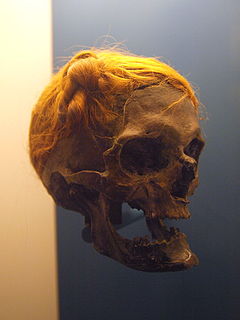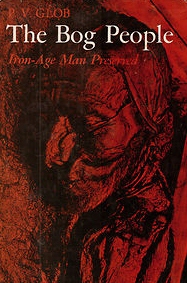
Lindow Man, also known as Lindow II and as Pete Marsh, is the preserved bog body of a man discovered in a peat bog at Lindow Moss near Wilmslow in Cheshire, North West England. The remains were found on 1 August 1984 by commercial peat cutters. Lindow Man is not the only bog body to have been found in the moss; Lindow Woman was discovered the year before, and other body parts have also been recovered. The find was described as "one of the most significant archaeological discoveries of the 1980s" and caused a media sensation. It helped invigorate study of British bog bodies, which had previously been neglected.

The Tollund Man is a naturally mummified corpse of a man who lived during the 5th century BC, during the period characterised in Scandinavia as the Pre-Roman Iron Age. He was found in 1950, preserved as a bog body, on the Jutland peninsula, in Denmark. The man's physical features were so well preserved that he was mistaken for a recent murder victim. Twelve years before his finding, another bog body, Elling Woman, was found in the same bog.

A bog body is a human cadaver that has been naturally mummified in a peat bog. Such bodies, sometimes known as bog people, are both geographically and chronologically widespread, having been dated to between 8000 CE and the Second World War. The unifying factor of the bog bodies is that they have been found in peat and are partially preserved; however, the actual levels of preservation vary widely from perfectly preserved to mere skeletons.

Yde Girl is a bog body found in the Stijfveen peat bog near the village of Yde, Netherlands. She was found on 12 May 1897 and was reputedly uncannily well-preserved when discovered, but by the time the body was turned over to the authorities two weeks later it had been severely damaged and deteriorated. Most of her teeth and hair had been pulled from the skull. The peat cutting tools had also been reported to have severely damaged the body.

Fashion in the period 1690–1740 in European and European-influenced countries is characterized by a widening silhouette for both men and women following the tall, narrow look of the 1680s and 90s. This era is defined as late Baroque/Rococo style. The new fashion trends introduced during this era had a greater impact on society, affecting not only royalty and aristocrats, but also middle and even lower classes. Clothing during this time can be characterized by soft pastels, light, airy, and asymmetrical designs, and playful styles. Wigs remained essential for men and women of substance, and were often white; natural hair was powdered to achieve the fashionable look. The costume of the eighteenth century, if lacking in the refinement and grace of earlier times, was distinctly quaint and picturesque.

The Haraldskær Woman is the name given to a bog body of a woman preserved in a bog in Jutland, Denmark, and dating from about 490 BC. Workers found the body in 1835 while excavating peat on the Haraldskær Estate. The anaerobic conditions and acids of the peat bog contributed to the body's excellent preservation. Not only was the intact skeleton found, but so were the skin and internal organs. Scientists settled disputes about the age and identity of this well preserved body in 1977, when radiocarbon dating determined conclusively that the woman's death occurred around the 5th century BC.

The Saltmen were discovered in the Chehrabad salt mines, located on the southern part of the Hamzehlu village, on the west side of the city of Zanjan, in the Zanjan Province in Iran. By 2010, the remains of six men had been discovered, most of them accidentally killed by the collapse of galleries in which they were working. The head and left foot of Salt Man 1 are on display at the National Museum of Iran in Tehran.

Windeby I is the name given to the bog body found preserved in a peat bog near Windeby, Northern Germany, in 1952. Until recently, the body was also called the Windeby Girl, since an archeologist believed it to be the body of a 14-year-old girl, because of its slight build. Prof. Heather Gill-Robinson, a Canadian anthropologist and pathologist, used DNA testing to show the body was actually that of a sixteen-year-old boy. The body has been radiocarbon-dated to between 41 BCE and 118 CE.

Huldremose Woman, or Huldre Fen Woman, is a female bog body recovered in 1879 from a peat bog near Ramten, Jutland, Denmark. Analysis by Carbon 14 dating indicates that she lived during the Iron Age, sometime between 160 BCE and 340 CE. The mummified remains are exhibited at the National Museum of Denmark. The elaborate clothing worn by Huldremose Woman has been reconstructed and displayed at several museums.

The Elling Woman is a bog body discovered in 1938 west of Silkeborg, Denmark. The Tollund Man was later discovered just c. 60 m (200 ft) away, twelve years after the Elling Woman's discovery. The Elling Woman was mistakenly described as a man in P.V. Glob's book, The Bog People, when it was published in 1965.

Osterby Man or the Osterby Head is a bog body of which only the skull and hair survived. It was discovered in 1948 by peat cutters to the southeast of Osterby, Germany. The hair is tied in a Suebian knot. The head is at the State Archaeological Museum at Gottorf Castle in Schleswig, Schleswig-Holstein.
The Borremose bodies are three bog bodies that were found in the Borremose peat bog in Himmerland, Denmark. Recovered between 1946 and 1948, the bodies of a man and two women have been dated to the Nordic Bronze Age. In 1891, the Gundestrup cauldron was found in a nearby bog.
The Gunnister Man is the remains of a late 17th or early 18th century man found by two Shetlanders in a peat bog not far from the junction of the A970 road in Gunnister, Shetland, Scotland. The bog body was found on 12 May 1951 as the men were digging peat for fuel. A stone placed by the Northmavine History Group now marks the find location.

Gallagh Man is the name given to a preserved Iron Age bog body found in County Galway, Ireland, in 1821. The remains date to c. 470–120 BC, and are of a six-foot (1.8 m) tall, healthy male with dark and reddish hair, who is estimated to have been around 25 years old at the time of death. The presence of a withy hoop – rope made from twisted willow twigs – found wrapped around his throat indicates that he was strangled during a ritual killing or executed as a criminal.
Alfred Dieck was a German archaeologist internationally recognised for the scientific studies on bog bodies and bog finds. Since the early 1990s, the results of his scientific work have been critically reviewed and found to be wrong in major parts.

Fashion in the twenty years between 1775–1795 in Western culture became simpler and less elaborate. These changes were a result of emerging modern ideals of selfhood, the declining fashionability of highly elaborate Rococo styles, and the widespread embrace of the rationalistic or "classical" ideals of Enlightenment philosophes.

The Bog People: Iron-Age Man Preserved is an archaeological study of the bog bodies of Northern Europe written by the Danish archaeologist P.V. Glob. First published in 1965 by Gyldendal under the Danish title of Mosefolket: Jernalderens Mennesker bevaret i 2000 År, it was translated into English by the English archaeologist Rupert Bruce-Mitford and published by Faber and Faber in 1969. In 1966 it was translated into German by Thyra Dohrenburg and published by Winkler Werlag Munich under the title Die Schläfer im Moor.

The Braak Bog Figures are two wooden carvings discovered in 1947 in a peat bog in Braak, Schleswig-Holstein, Northern Germany. Part of a larger tradition of similar figures spanning the period from the Neolithic to the Middle Ages, they are human-like in appearance and have been carbon dated to the 2nd or 3rd century BCE; the Schleswig-Holstein state archaeology museum puts them as far back as 400BCE. Several hypotheses have been proposed to explain their function and what they may represent, from depictions of deities to ancestor worship.

The conservation and restoration of human remains involves the long-term preservation and care of human remains in various forms which exist within museum collections. This category can include bones and soft tissues as well as ashes, hair, and teeth. Given the organic nature of the human body, special steps must be taken to halt the deterioration process and maintain the integrity of the remains in their current state. These types of museum artifacts have great merit as tools for education and scientific research, yet also have unique challenges from a cultural and ethical standpoint. Conservation of human remains within museum collections is most often undertaken by a conservator-restorer or archaeologist. Other specialists related to this area of conservation include osteologists and taxidermists.



















